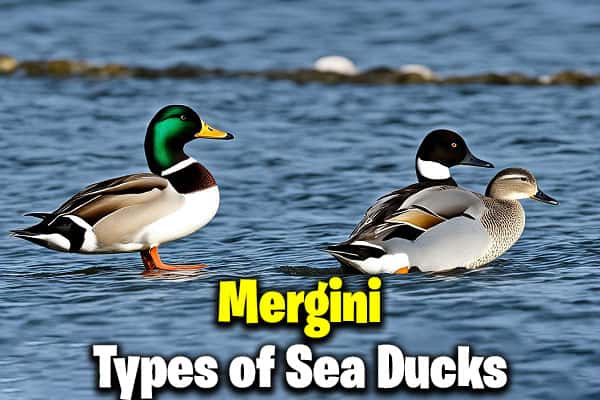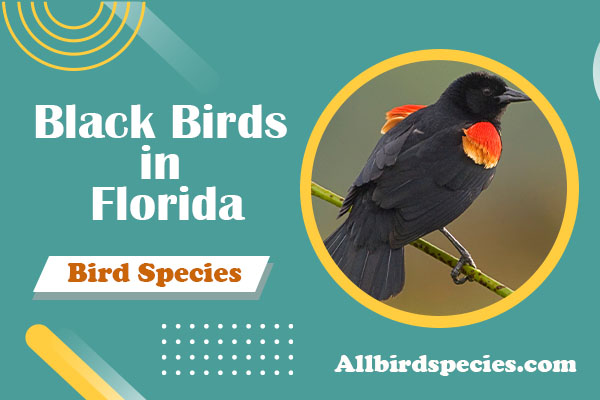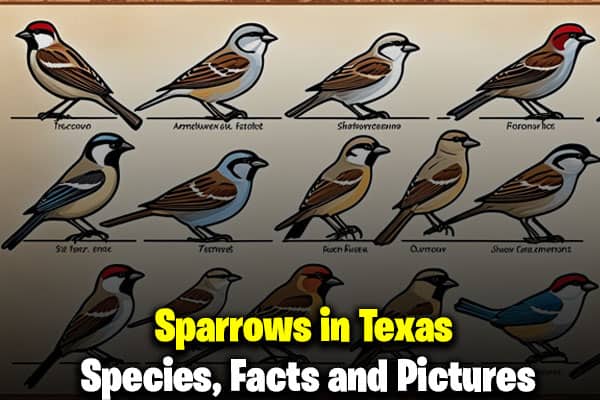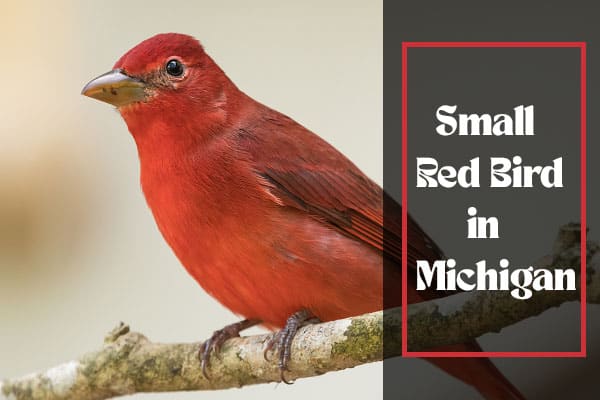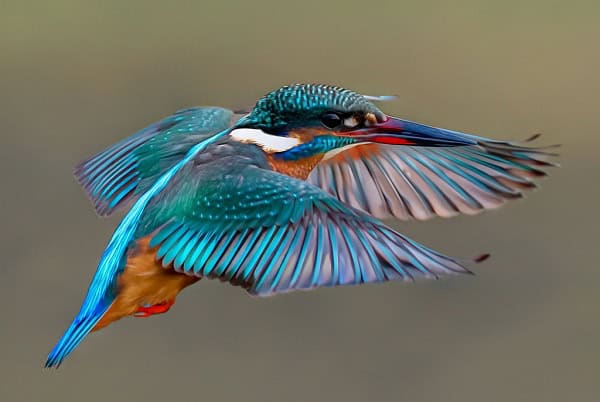9 Types of Sea Ducks (Mergini) ID Guide With Photos
Ever wondered why some birds do well in the ocean but others don’t? Exploring sea ducks, especially those in the Mergini subfamily, shows their amazing diversity and how they adapt to the sea. Knowing about the different sea ducks is key for birdwatchers and nature lovers. These birds have unique traits that make them stand out.
This guide will help you learn more about sea duck identification. We’ll look at their distinct traits, where they live, and how they behave. From the elegant Common Eider to the striking Harlequin Duck, the Mergini family has many species worth noticing. Let’s start this adventure and learn more about the sea duck family!
Introduction to Sea Ducks
Sea ducks are fascinating birds that live in the ocean. They belong to the Anatidae family and have special traits for living in the sea. Learning about Introduction to Sea Ducks shows how important they are in their homes.
These birds live in places like coastal waters, estuaries, and the open sea. Each type of sea duck has its own way of eating and breeding. They play a big part in making the ocean’s life rich and diverse.
Sea ducks are more than just interesting birds. They tell us about the health of the ocean. Their eating habits help keep the ocean’s food chain balanced. By learning about where they live, we can see why we need to protect their homes.
| Aspect | Description |
|---|---|
| Habitat | Coastal waters, estuaries, and open seas |
| Feeding | Diverse diet including fish, mollusks, and crustaceans |
| Role in Ecosystem | Indicator species helps maintain marine balance |
| Conservation Challenges | Habitat loss, climate change, and pollution |
What Are Sea Ducks?
Sea ducks are interesting birds that belong to the Merginae subfamily. They have special marine adaptations that help them live in coastal and open-water areas. There are about 15 different kinds of sea ducks, including eiders, scoters, goldeneyes, and mergansers. Each type is important to its ecosystem, helping keep marine life in balance.
Sea ducks live in the northern hemisphere, mostly in places with lots of water plants and small fish. They need healthy marine habitats to survive. Here’s a table that gives a quick look at some sea ducks, showing their unique features and where they live.
| Species | Habitat | Diet | Notable Feature |
|---|---|---|---|
| Common Eider | Coastal waters | Marine invertebrates | Soft down feathers |
| Surf Scoter | Oceanic coastal regions | Shellfish and crustaceans | Distinctive colorful bill |
| Barrow’s Goldeneye | Lakes and rivers | Insects and small fish | Unique breeding plumage |
| Hooded Merganser | Freshwater ponds | Fish and amphibians | Fan-shaped crest |
Characteristics of Sea Ducks
Sea ducks have amazing adaptations that let them live in the sea. They have evolved to do well in their water homes. These birds have special looks and ways of acting that help them hunt, swim, and breed in tough places.
Adaptations to Marine Environments
Sea ducks have special glands that help them get rid of salt from seawater. This is key for keeping their bodies balanced with water. They also have diving skills that help them find food underwater. Their bodies are made to be buoyant, letting them move easily in the water.
Physical Features Distinguishing Sea Ducks
Sea ducks have strong bodies made for the sea. Their webbed feet are great for swimming. Many have bills with serrated edges that help them catch fish. These features make them better at finding food and surviving in different places.
Types of Sea Ducks
The world of sea ducks is full of variety, with the Mergini Family at its heart. This group includes many species, each living in its special way in the ocean. By learning about these sea ducks, we can see how they play a big part in their environments.
Overview of Mergini Family
The Mergini Family is home to many sea ducks, like eiders, scoters, goldeneyes, mergansers, harlequins, and buffleheads. Each species has its role in nature. Let’s take a closer look at some of these important sea ducks:
- Eiders – Known for their soft down feathers, often used in luxury bedding.
- Scoters – Characterized by their robust bodies and distinctive coloration.
- Goldeneyes – Recognizable by their striking iridescent heads and swift swimming skills.
- Mergansers – Equipped with narrow bills, ideal for catching fish.
- Harlequin Ducks – Often found in fast-moving waters, exhibiting bold plumage.
- Buffleheads – Small but lively, proficient divers and fond of freshwater habitats.
Common Eider (Somateria mollissima)
The Common Eider is a standout among sea duck species. Its unique looks and social ways grab the interest of bird lovers and nature fans. You’ll see its sleek body and bright colors, which are key Eider traits.

Common Eiders live in coastal areas, doing well in the sea. They like rocky shores and places with lots of food. They eat mostly mollusks, crustaceans, and other sea creatures, showing how well they’ve adapted to sea life.
When it comes to breeding, the Common Eider has its ways. They nest on coastal islands, where females lay eggs in hidden grasses. Once hatched, the ducklings quickly follow their mothers to the water to start looking for food.
Changes in the environment are big threats to the Common Eider. Climate change impacts their home, food, and where they nest. We need conservation efforts to help this sea duck species thrive despite these challenges.
| Aspect | Description |
|---|---|
| Size | 20-26 inches in length |
| Wingspan | 36-45 inches |
| Coloration | Distinct male plumage with black and white; females are brown |
| Habitat | Coastal waters, rocky shores, and islands |
| Diet | Mollusks, crustaceans, and marine invertebrates |
King Eider (Somateria spectabilis)
The King Eider is a standout among sea ducks, known for its large size and eye-catching look. Its Distribution and Breeding Habits tell us a lot about this bird’s life.
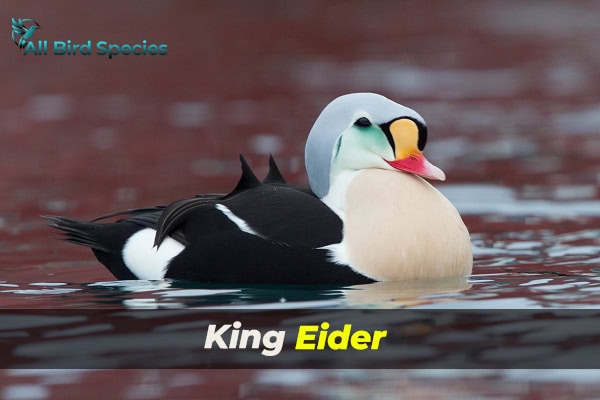
Description and Distribution
The King Eider has a unique look, with males showing off black, white, and orange on their heads. Females are more brown and mottled. They live in the Arctic and subarctic areas.
You can find them along the coasts of northeastern Canada, Greenland, and northern Europe. In winter, they move to the northeastern United States and the North Atlantic. They like coastal waters and tundra habitats.
Breeding Habits and Habitat
King Eiders start breeding in late May and go until July. Males show off their bright colors to attract females. They like to breed in tundra wetlands with lots of plants and shallow water.
- Nesting happens in hidden spots among grasses or mosses.
- Females lay 4 to 7 eggs and incubate them alone.
- Ducklings take a few weeks to leave the nest and still need their mothers for a while.
Scoters: Black, White-winged, and Surf Scoters
Scoters are fascinating diving ducks with unique looks and behaviors. This section focuses on three types: the Black Scoter, the White-winged Scoter, and the Surf Scoter. Learning about their traits and habits helps us appreciate these marine birds more.

Characteristics of Scoters
Scoters have many striking features that show how well they live in water. The Black Scoter has dark feathers and a special yellow knob on its bill. The White-winged Scoter is known for its white wing patches. Surf Scoters are easy to spot with their bright heads and unique bills.
- Black Scoter: Often seen in large flocks, they prefer coastal habitats.
- White-winged Scoter: Easily identified by their white wing patches, which are visible in flight.
- Surf Scoter: Known for their vibrant coloring, especially in males, making them easily recognizable.
Feeding Habits and Migration Patterns
Scoters eat mainly marine life like mollusks and crustaceans. They dive to find food at different depths, sometimes alone, sometimes with others. Their migration paths vary a lot; many Scoters travel long distances between where they breed and where they spend the winter.
The Black Scoter spends the winter along the Atlantic coast. The White-winged Scoter also likes this area but is found more in the Pacific. Surf Scoters move from their breeding grounds in Canada and Alaska to both U.S. coasts for the winter.
Goldeneyes: Barrow’s and Common
Goldeneyes live in many places, showing how well they fit into different ecosystems. The Barrow’s Goldeneye and the Common Goldeneye are interesting to compare. The Barrow’s Goldeneye has a round head and a white crescent on its face. This makes it easy to tell apart from others. The Common Goldeneye looks different, with a sleek head and a white spot near its eye.

Both Goldeneyes like to nest in places near fresh water, like lakes and ponds. They choose spots with lots of plants around. The female ducks take care of the eggs while the males show off with their courtship displays.
Barrow’s Goldeneyes dive in shallower water to find food like aquatic insects. Common Goldeneyes go deeper to catch fish and other invertebrates. This shows how they play different roles in their environments.
| Feature | Barrow’s Goldeneye | Common Goldeneye |
|---|---|---|
| Physical Characteristics | Rounded head, white crescent | Greenish-black head, white facial spot |
| Breeding Habitats | Freshwater lakes, ponds | Rivers, deeper freshwater areas |
| Foraging Behavior | Dives in shallower waters | Prefers deeper waters for fish |
Bufflehead (Bucephala albeola)
The Bufflehead is a small, vibrant sea duck with striking black and white feathers. It’s important to know about its Breeding Habitats and Wintering Habitats. This helps us understand its life cycle and where it goes during migration.

Breeding and Wintering Habitats
During the breeding season, Buffleheads like freshwater ponds and marshes full of plants. These places offer great spots for nesting and lots of food. Female Buffleheads pick safe spots near willows or tall grasses to lay their eggs.
For winter, Buffleheads move to coastal areas. They like sheltered bays, estuaries, and places with lots of open water. This lets them find food like small fish and invertebrates easily. Their small size and strong flying skills help them live in different places all year.
| Season | Habitat Type | Characteristics |
|---|---|---|
| Breeding | Freshwater Ponds | Rich in aquatic vegetation, nesting areas near cover |
| Wintering | Coastal Regions | Sheltered bays and estuaries with open water |
Harlequin Duck (Histrionicus histrionicus)
The Harlequin Duck is known for its bright and detailed feathers. It’s a standout among sea ducks. You can find it along the northern coasts of North America and parts of Asia. It loves fast rivers and coastal areas.
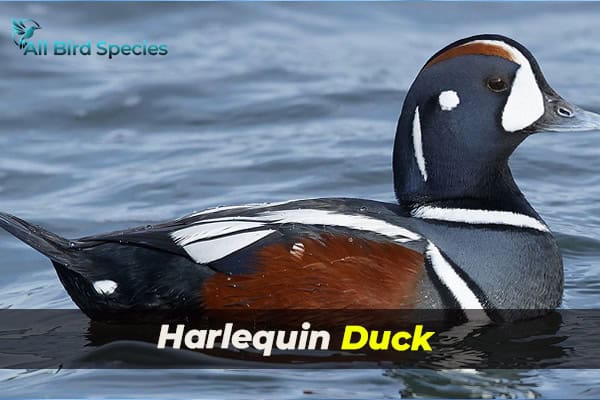
These ducks have special ways of breeding. They nest in hidden spots near water, like rocky places or thick plants. The females lay 5 to 7 eggs and keep them warm for about 30 days. Soon after hatching, the ducklings can swim, showing how well they fit into their home.
The Harlequin Duck needs a clean home to survive. It eats things like invertebrates, water insects, and small fish from clean waters. But, it faces many dangers, like losing its home to cities, pollution, and climate change. We must work to protect this beautiful duck and its home.
| Aspect | Details |
|---|---|
| Scientific Name | Histrionicus histrionicus |
| Breeding Season | Late spring to early summer |
| Nesting Habitats | Rocky crevices, dense vegetation near water |
| Average Eggs Laid | 5 – 7 eggs |
| Primary Diet | Invertebrates, aquatic insects, small fish |
| Threats | Habitat loss, pollution, climate change |
| Conservation Status | Concerned |
Long-tailed Duck (Clangula hyemalis)
The Long-tailed Duck is a standout among sea ducks, known for its distinctive features. Its long, slender tail is especially noticeable during mating season. This makes it a favorite among birdwatchers and casual observers. Learning about its looks and behavior will deepen your appreciation for this unique bird.

Distinctive Features and Behavior
This duck has many noticeable traits. It sports a striking plumage with dark and light colors, making it a sight to behold. Male ducks show off their best during breeding season with intricate patterns to attract mates. Their long tail and vibrant colors make them easy to spot.
Long-tailed Ducks are social birds, often found in large groups during migration and winter. They are active feeders, diving underwater for small fish and invertebrates. Their ability to live in both fresh and saltwater shows their adaptability in different environments.
| Distinctive Features | Behavior |
|---|---|
| Long, slender tail | Social, migratory |
| Vibrant breeding plumage | Dives for food |
| A mix of dark and light colors | Forms large flocks |
Mergansers: Common, Red-breasted, and Hooded
Mergansers are known for their eye-catching looks and unique way of eating. They include the Common, Red-breasted, and Hooded types. These ducks have serrated bills perfect for catching fish. Their feeding techniques show how they survive and what kind of places they like to live in.
Feeding Techniques of Mergansers
Mergansers are great at catching fish. Let’s explore how they do it:
- Diving: They dive deep into the water to catch fish. They can hold their breath for a long time, helping them hunt better.
- Surface Pursuit: Sometimes, they chase fish right at the water’s surface, moving fast to catch them off guard.
- Group Hunting: Mergansers may work together to herd fish into groups. This makes it easier for them to catch.
- Picking: Their bills are shaped in a way that lets them hold onto slippery fish tightly, so they don’t get away.
These feeding methods show how skilled mergansers are. They also show what kind of places they prefer to live in. These places include lakes, rivers, and coastal areas where there are plenty of fish.
Conservation Status of Sea Ducks
The Conservation Status of sea ducks shows how complex environmental factors affect their numbers. Knowing these challenges helps us protect these amazing marine birds.
Threats to Sea Duck Populations
Sea ducks face many threats that threaten their survival:
- Habitat Loss: Wetland drainage and coastal development reduce their homes for nesting and finding food.
- Climate Change: Changes in weather and temperature mess with their migration paths and food supply.
- Hunting: Hunting, even when regulated, can harm populations if combined with other threats.
Conservation Efforts and Strategies
Many efforts work to improve the Conservation Status of sea ducks:
- Habitat Protection: Protecting coastal and wetland habitats is crucial.
- Research and Monitoring: Studies track populations and understand threats better.
- Public Awareness Campaigns: Teaching communities about sea ducks helps everyone work together to protect them.
With ongoing commitment to these efforts, we can secure a future for sea ducks. This lets these beautiful birds live in their natural homes.
Final Thoughts:
In this journey into sea ducks, you’ve learned a lot about their special traits and key roles in the ocean. From the stunning common eider to the cute Bufflehead, these birds are a wonder of nature. They also show us how important it is to keep their homes safe.
Thinking about these amazing birds, it’s clear they need our help. Things like destroying their homes and climate change threaten their numbers. We must keep researching and taking action to protect them. Supporting efforts to save these birds is key to making sure they’re around for the future.
Learning about sea ducks makes us more responsible for their future. By knowing and caring for these special birds, we can help save our planet. This way, we can keep these beautiful waterfowl around for many years to come.

